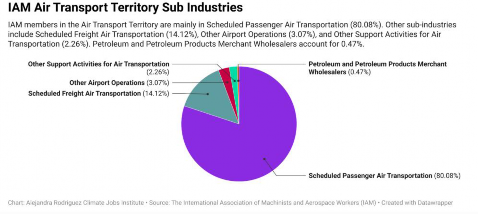
< Previous | Contents | Next >
The IAM Air Transport Territory represents over 60,000 workers, including mechanics, customer service representatives, ramp workers, flight attendants, security agents and Network Operations Control agents for commercial and freight travel. These members are spread across 25 states, with Illinois making up over 40% of the Territory’s workforce. Just five states–Illinois, Texas, Washington, Hawaii, and California–account for over 75% of the territory’s membership.122 Major employers in the industry include United Airlines, Southwest Airlines, American Airlines, Hawaiian Airlines, Spirit Airlines, Alaska Airlines, and Swissport.123 A small percentage of the IAM Air Transport members work in wholesale distribution of petroleum and petroleum products, which are essential for fueling and maintaining aircraft.124

The aviation sector is a major carbon emitter, and it is also vulnerable to the effects of climate change. Record heat affects aircraft performance, reducing plane carrying capacity, and even grounding flights.125 Frequent and severe extreme weather events, like floods, hurricanes, tornados, rising seas and more, damage essential infrastructure, ground flights, and increase hazards at airports.126 “Climate change has impacted the industry on the whole,” says Air Transport Territory Chief of Staff Edison Fraser, “whether it's the members or the passengers or the airlines”.127 Left unaddressed, extreme weather will continue to upend working conditions and threaten the air transport industry itself.
IAM members in the industry face increasing on-the-job risks linked to climate change. A 2021 report from the European Transit Union Institute identified several heat-related risks to workers,
![]()
123 International Association of Machinists and Aerospace Workers.
124 U.S. Bureau of Labor Statistics, “Industries at a Glance.”
125 Salerno, “Can It Be Too Hot for a Plane to Fly? How the Phoenix Airport Is Handling Record Heat.”
126 Williams, “Climate Change Is Disrupting Air Travel.”
including heat stroke, cramps, exhaustion, organ failure, and fever.128 People laboring under heat stress are more likely to suffer accidents and injure themselves or others, and prolonged exposure to extreme heat and UV also increases the risk of chronic eye and organ illnesses.129 This also raises equity concerns, as large percentages of airport service workers in the United States are immigrants and people of color.130
Working in primarily non-climate controlled facilities – such as on tarmacs or in trucks – poses its own health issues.131 “Most of those workers are black and brown, and man, are they suffering,” reports Human Rights Director Nicole Fears. “They are subjected to heat that we know is unhealthy. 100 degrees doesn’t feel like 100 degrees anymore.”132 According to IAM Director of Safety and Health Michael Oathout, workers often interpret heat stress as common illnesses, and go to their doctor, who may not account for or fully understand workplace hazards.133 The best way to ensure safe working conditions is to address new hazards before they arise.
As airlines scramble to deal with climate-caused disruptions, working conditions in the industry are deteriorating. The FAA reports that weather is responsible for more than 75% of flight delays–and weather patterns are becoming more difficult to predict.134 Customer service workers shoulder the burden of delays, prolonged flights, reroutes, and last-minute cancellations by managing angry travelers and assisting those in difficult situations.135 Extended travel times mean longer hours on the job, and employers often push mandatory overtime to cover for unexpected disruptions.136 Leaders in the Air Transport Division have negotiated increased compensation and limits to mandatory overtime, and such efforts are likely to continue as weather emergencies take a larger toll on the industry.
Rising heat has been an important issue in the campaign at Delta Airlines, where the IAM is organizing ramp, cargo, and tower workers. For example, many Delta workers are required to wear “bump caps'' to reduce the risk of head injury. However, in many classifications, the caps serve no obvious safety purpose and create new hazards by trapping heat. According to Oathout, Delta workers have recorded temperatures under the caps to be 20–30 degrees above outdoor temperatures.137
![]()
129 Narocki.
134 Oathout.
136 Fraser.